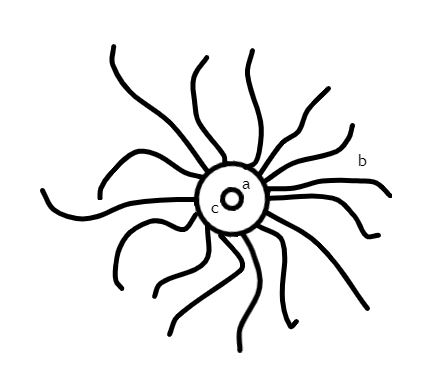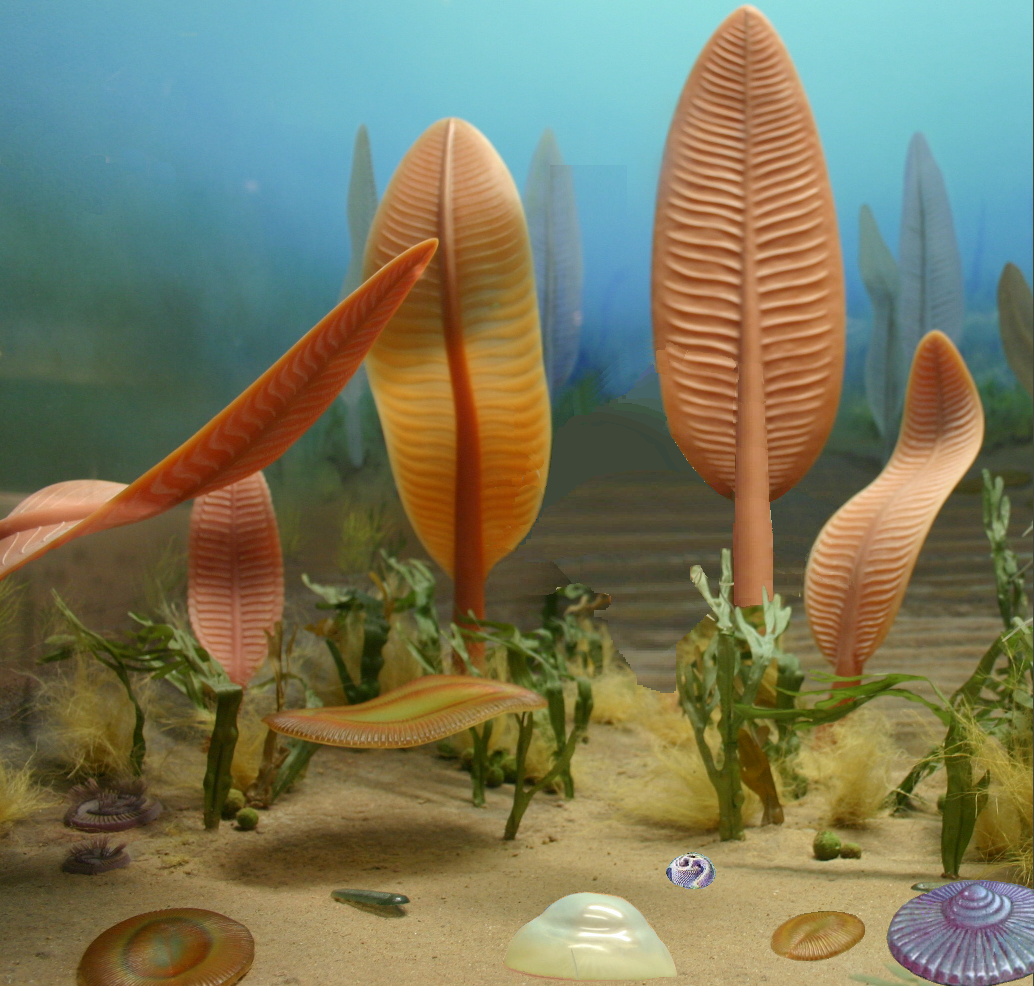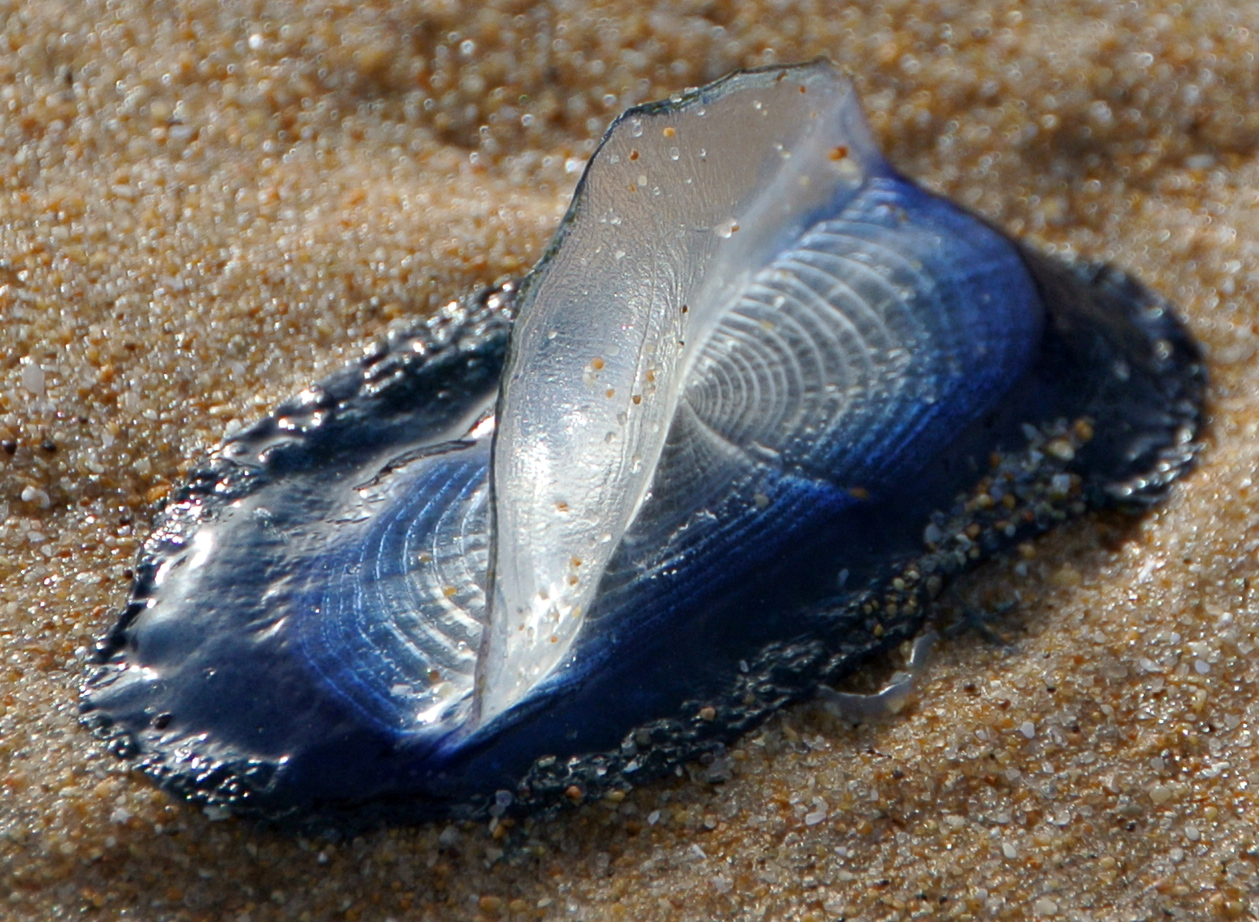|
Hiemalora Stellaris
''Hiemalora'' is a fossil of the Ediacaran biota, reaching around 3 cm in diameter, which superficially resembles a sea anemone. The genus has a sack-like body with faint radiating lines originally interpreted as tentacles, but discovery of a frond-like structure seemingly attached to some ''Heimalora'' has added weight to a competing interpretation: that it represents the holdfast of a larger organism. In 2020, a new study was published that described nine different specimens from the Indreelva member, Digermulen Peninsula, Finnmark (Arctic Norway). The specimens described in the paper have high degrees of variation between morphologies and within the specimens that are thought to be of the same species. Some of the representative fossils from that paper either show multiple Aspidella-like structures on the same specimen, or a Primocandelabrum-like cone visible in one of the fossils. All of the examples of fossils in the publication were determined to most likely represen ... [...More Info...] [...Related Items...] OR: [Wikipedia] [Google] [Baidu] |
Ediacaran
The Ediacaran ( ) is a geological period of the Neoproterozoic geologic era, Era that spans 96 million years from the end of the Cryogenian Period at 635 Million years ago, Mya to the beginning of the Cambrian Period at 538.8 Mya. It is the last period of the Proterozoic geologic eon, Eon as well as the last of the so-called "Precambrian supereon", before the beginning of the subsequent Cambrian Period marks the start of the Phanerozoic Eon, where recognizable fossil evidence of life becomes common. The Ediacaran Period is named after the Ediacara Hills of South Australia, where trace fossils of a diverse community of previously unrecognized lifeforms (later named the Ediacaran biota) were first discovered by geologist Reg Sprigg in 1946. Its status as an official geological period was ratified in 2004 by the International Union of Geological Sciences (IUGS), making it the first new geological period declared in 120 years. Although the period took namesake from the Ediacara Hills ... [...More Info...] [...Related Items...] OR: [Wikipedia] [Google] [Baidu] |
Aspidella
:Aspidella'' is also a homonym for the mushroom genus '' Saproamanita. ''Aspidella'' is an Ediacaran disk-shaped fossil of uncertain affinity. It is known from the single species ''A. terranovica''. Morphology ''Aspidella'' consists of disk-shaped fossils, with concentric rings and/or centripetal rays. The diameter of circular ''Aspidella'' varies from 1 to 180 mm.Peterson. P. 131 Most individuals are between 4 and 10 mm, but smaller individuals would presumably have decayed before they could fossilize. Other ''Aspidella'' take the form of ellipses, 3–8 cm long and 1–4 cm wide. Most have a central pimple. The rim of all specimens is made up by ridge-edged rays and/or concentric rings. Ecology The rarity of large individuals probably indicates that ''Aspidella'' were r-strategists, producing numerous offspring of which most died young. It is most common in deep-water sediments, but is a constituent of most Ediacaran fossil assemblages, including tho ... [...More Info...] [...Related Items...] OR: [Wikipedia] [Google] [Baidu] |
Incertae Sedis
or is a term used for a taxonomy (biology), taxonomic group where its broader relationships are unknown or undefined. Alternatively, such groups are frequently referred to as "enigmatic taxa". In the system of open nomenclature, uncertainty at specific taxonomic levels is indicated by (of uncertain family), (of uncertain suborder), (of uncertain order) and similar terms. Examples * The fossil plant ''Paradinandra, Paradinandra suecica'' could not be assigned to any family, but was placed ''incertae sedis'' within the order Ericales when described in 2001. * The fossil ''Gluteus minimus (fossil), Gluteus minimus'', described in 1975, could not be assigned to any known animal phylum. The genus is therefore ''incertae sedis'' within the kingdom Animalia. * While it was unclear to which order the New World vultures (family Cathartidae) should be assigned, they were placed in Aves ''incertae sedis''. It was later agreed to place them in a separate order, Cathartiformes. * Boc ... [...More Info...] [...Related Items...] OR: [Wikipedia] [Google] [Baidu] |
Ediacaran Life
The Ediacaran (; formerly Vendian) biota is a taxonomic period classification that consists of all life forms that were present on Earth during the Ediacaran Period (). These were enigmatic tubular and frond-shaped, mostly sessile, organisms. Trace fossils of these organisms have been found worldwide, and represent the earliest known complex multicellular organisms. The term "Ediacara biota" has received criticism from some scientists due to its alleged inconsistency, arbitrary exclusion of certain fossils, and inability to be precisely defined. The Ediacaran biota may have undergone evolutionary radiation in a proposed event called the Avalon explosion, . This was after the Earth had thawed from the Cryogenian period's extensive glaciation. This biota largely disappeared with the rapid increase in biodiversity known as the Cambrian explosion. Most of the currently existing body plans of animals first appeared in the fossil record of the Cambrian rather than the Ediacaran. ... [...More Info...] [...Related Items...] OR: [Wikipedia] [Google] [Baidu] |
List Of Ediacaran Genera
The existence of life, especially that of animals, before the Cambrian had long been the subject of debate in paleontology. The apparent suddenness of the Cambrian explosion had no firm explanation, and Charles Darwin himself recognized the challenge it posed for his theory of evolution. While reports of Precambrian organisms have been made since Alexander Murray's 1868 discovery of ''Aspidella'', it wasn't until the discovery of ''Charnia'' in 1956 that considerable evidence of Precambrian life had been presented. The period immediately preceding the Cambrian, the Ediacaran, is now widely accepted of containing animal life. It spans from 635 to 540 million years ago, and covers approximately 2% of Earth's history. Taxonomists have purported a total of 245 described genera from the Ediacaran, 162 of which are accepted as valid. Key * Valid genus - Genera that are accepted by the scientific community * Synonym (taxonomy), Junior synonym - Alternative name for an already existi ... [...More Info...] [...Related Items...] OR: [Wikipedia] [Google] [Baidu] |
Cyclomedusa
''Cyclomedusa'' is a circular fossil of the Ediacaran biota; it has a circular bump in the middle and as many as five circular growth ridges around it. Many specimens are small, but specimens in excess of 20 cm are known. The concentric disks are not necessarily circular, especially when adjacent individuals interfere with each other's growth. Many radial segment lines — somewhat pineapple-like — extend across the outer disks. A few specimens show what might be a stem extending from the center in some direction or other. ''Cyclomedusa'' is widely distributed in Ediacaran strata, with a number of species described. It has also been found in sediments dating to the Tonian (~). ''Cyclomedusa'' was originally thought to be a jellyfish but some specimens seem to be distorted to accommodate adjacent specimens on the substrate, apparently indicating a benthic (bottom-dwelling) creature. The markings do not match the musculature pattern of modern jellyfish. The fossils have b ... [...More Info...] [...Related Items...] OR: [Wikipedia] [Google] [Baidu] |
Chondrophore
The chondrophores or porpitids are a small group of hydrozoans in the family Porpitidae. Though it derives from an outdated name for this lineage, some find the term ''chondrophore'' still useful as a synonym for members of the family Porpitidae – ''porpitids'' – when discussing the two genera contained in '' Porpita'' and ''Velella'', to avoid confusion with the near-identical genus name '' Porpita''. They all live at the surface of the open ocean, and are colonies of carnivorous, free-floating hydroids. The chondrophores look like a single organism, but are actually colonial animals, made up of orderly cooperatives of polyps living under specialized sail-structures. The colony's role in the plankton community is similar to that of pelagic jellyfish. The most familiar members of the family Porpitidae are the blue button ('' Porpita porpita'') and the by-the-wind sailor (''Velella velella''). Description The tiny individual animals are specialized to perform specific ... [...More Info...] [...Related Items...] OR: [Wikipedia] [Google] [Baidu] |
Cnidaria
Cnidaria ( ) is a phylum under kingdom Animalia containing over 11,000 species of aquatic invertebrates found both in fresh water, freshwater and marine environments (predominantly the latter), including jellyfish, hydroid (zoology), hydroids, sea anemones, corals and some of the smallest marine parasites. Their distinguishing features are an uncentralized nervous system distributed throughout a gelatinous body and the presence of cnidocytes or cnidoblasts, specialized cells with ejectable flagella used mainly for envenomation and capturing prey. Their bodies consist of mesoglea, a non-living, jelly-like substance, sandwiched between two layers of epithelium that are mostly one cell (biology), cell thick. Cnidarians are also some of the few animals that can reproduce both sexually and asexually. Cnidarians mostly have two basic body forms: swimming medusa (biology), medusae and sessility (motility), sessile polyp (zoology), polyps, both of which are radially symmetrical with mou ... [...More Info...] [...Related Items...] OR: [Wikipedia] [Google] [Baidu] |
Medusae
Jellyfish, also known as sea jellies or simply jellies, are the medusa-phase of certain gelatinous members of the subphylum Medusozoa, which is a major part of the phylum Cnidaria. Jellyfish are mainly free-swimming marine animals, although a few are anchored to the seabed by stalks rather than being motile. They are made of an umbrella-shaped main body made of mesoglea, known as the ''bell'', and a collection of trailing tentacles on the underside. Via pulsating contractions, the bell can provide propulsion for locomotion through open water. The tentacles are armed with stinging cells and may be used to capture prey or to defend against predators. Jellyfish have a complex life cycle, and the medusa is normally the sexual phase, which produces planula larvae. These then disperse widely and enter a sedentary polyp phase which may include asexual budding before reaching sexual maturity. Jellyfish are found all over the world, from surface waters to the deep sea. Sc ... [...More Info...] [...Related Items...] OR: [Wikipedia] [Google] [Baidu] |
Primocandelabrum
''Primocandelabrum'' is a genus of rangeomorph known from the Avalon-type Ediacaran biota. It makes up the brunt of some bedding plane assemblages. ''Primocandelabrum'' was described by Hofmann, O'Brien, and King in 2008. Three more species were later found in 2017 within the upper layers of the Bradgate Formation of the Charnwood Forest. Diversity Fossil specimens of ''Primocandelabrum'' from Charnwood Forest: * ''Primocandelabrum'' ''aelfwynnia'' Kenchington & Wilby, 2017 * ''Primocandelabrum'' ''boyntoni'' Kenchington & Wilby, 2017 * ''Primocandelabrum'' ''aethelflaedia'' Kenchington & Wilby, 2017 Fossil specimens of ''Primocandelabrum'' from Bonavista Peninsula: * ''Primocandelabrum hiemaloranum'' Hofmann, 2008 * ''Primocandelabrum sp.'' Hofmann, 2008 Etymology The fossils are thus named since it resembles candelabra, giving it its signature genus name. See also * List of Ediacaran genera * Hylaecullulus ''Hylaecullulus fordi'', also described as dumbbells, is an ... [...More Info...] [...Related Items...] OR: [Wikipedia] [Google] [Baidu] |
Arctic Norway
Northern Norway (, , ; ) is a geographical region of Norway, consisting of the three northernmost counties Nordland, Troms and Finnmark, in total about 35% of the Norwegian mainland. Some of the largest towns in Northern Norway (from south to north) are Mo i Rana, Bodø, Narvik, Harstad, Tromsø (city), Tromsø and Alta (town), Alta. Northern Norway is often described as the land of the midnight sun and the land of the Aurora (astronomy), northern lights. Farther north, halfway to the North Pole, is the Arctic archipelago of Svalbard, traditionally not regarded as part of Northern Norway. The region is multi-cultural, housing not just Norwegians but also the indigenous peoples, indigenous Sami people, Norwegian Finns (known as Kven people, Kvens, distinct from the "Forest Finns" of Southern Norway) and Russians, Russian populations (mostly in Kirkenes). The Norwegian language dominates in most of the area; Sami speakers are mainly found inland and in some of the fjord areas of N ... [...More Info...] [...Related Items...] OR: [Wikipedia] [Google] [Baidu] |
Mikhail A
Michael is a common masculine given name derived from the Hebrew phrase ''mī kāʼēl'', 'Who slike-El', in Aramaic: ܡܝܟܐܝܠ (''Mīkhāʼēl'' ). The theophoric name is often read as a rhetorical question – "Who slike he Hebrew God El?", whose answer is "there is none like El", or "there is none as famous and powerful as God." This question is known in Latin as ''Quis ut Deus?'' Paradoxically, the name is also sometimes interpreted as, "One who is like God."Omnium Sanctorum Hiberniae"Michael - one who is like unto God"(This interpretation would be seen as heretical in some religions, but it is fairly common nonetheless.) An alternative spelling of the name is ''Micheal''. While ''Michael'' is most often a masculine name, it is also given to women, such as the actresses Michael Michele and Michael Learned, and Michael Steele, the former bassist for the Bangles. Patronymic surnames that come from Michael include '' Carmichael, DiMichele, MacMichael, McMichael, Mic ... [...More Info...] [...Related Items...] OR: [Wikipedia] [Google] [Baidu] |









